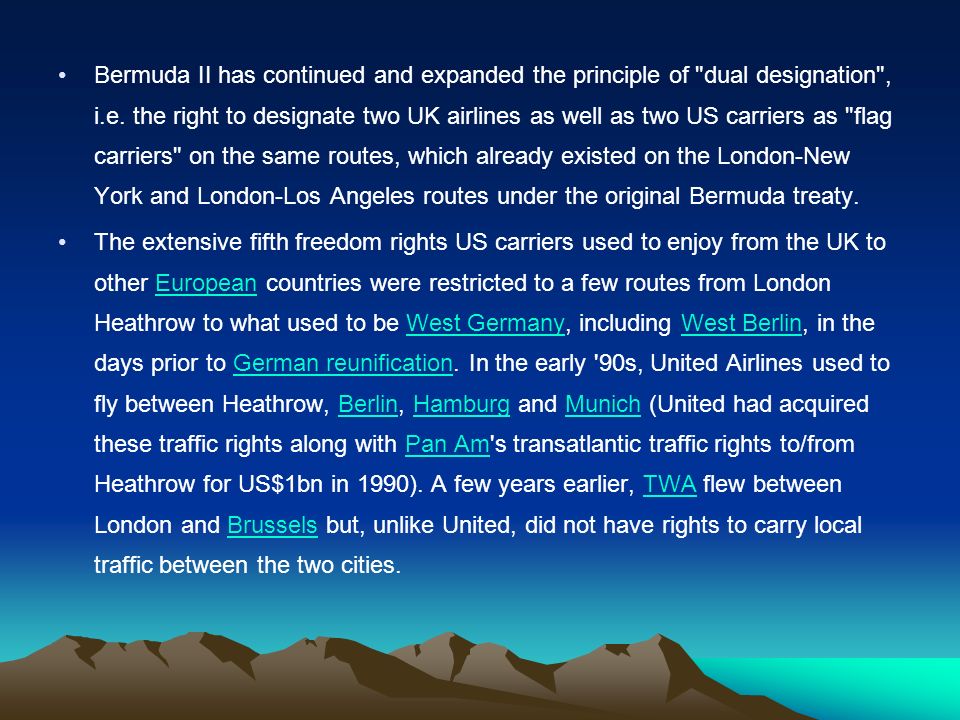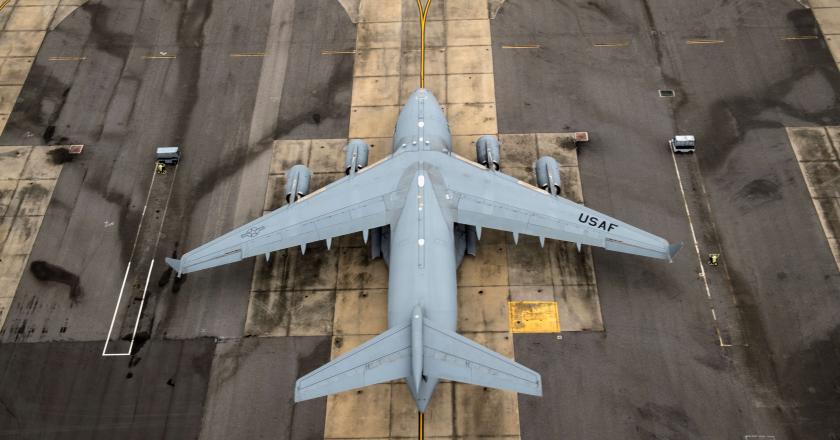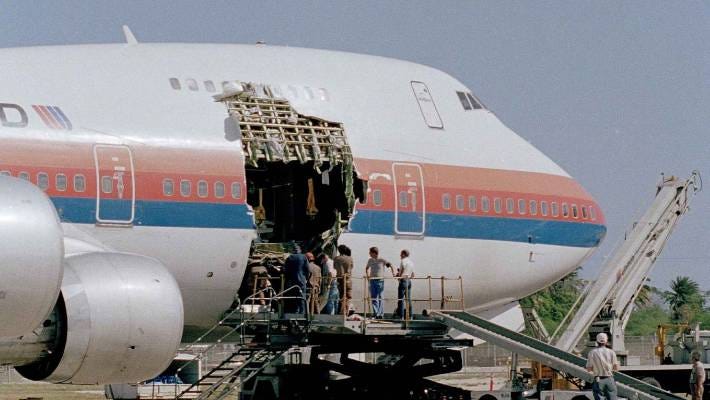Public International Aviation Law - ppt download

The Chicago Convention. Bilateral Air Transport Agreement. Bermuda I, Bermuda II. The Freedoms of the Air. Open Skies Agreement.
It is the foundation for our current system of international transportation by air. The Chicago Convention states that each state has complete and exclusive sovereignty over the airspace above its territory . Care was taken during the drafting of the Chicago Convention to specifically exclude all military, police, customs, and other state operated aircraft from the operation of the convention.
The Convention on International Civil Aviation, also known as the Chicago Convention, established the International Civil Aviation Organization (ICAO), a specialized agency of the United Nations charged with coordinating and regulating international air travel. The Convention establishes rules of airspace, aircraft registration and safety, and details the rights of the signatories in relation to air travel. The Convention also exempts air fuels from tax.
In October of the same year, ICAO became a specialized agency of the United Nations Economic and Social Council (ECOSOC). The Convention has since been revised eight times (in 1959, 1963, 1969, 1975, 1980, 1997, 2000 and 2006). Links to all versions of the document can be found in the external links section. The original signed document resides in the National Archives of the United States.
The Convention is supported by eighteen annexes containing Standards and Recommended Practices (SARPs). The Annexes are amended regularly by ICAO and are as follows: Annex 1 - Personnel Licensing. Annex 2 - Rules of the Air. Annex 3 - Meteorological Service for International Air Navigation. Vol. I - Core SARPs. Vol. II - Appendices and Attachments. Annex 4 - Aeronautical Charts. Annex 5 - Units of Measurement to be used in Air and Ground Operations.
Part I - International Commercial Air Transport – Aero-planes. Part II - International General Aviation – Aero-planes. Part III - International Operations - Helicopters. Annex 7 - Aircraft Nationality and Registration Marks. Annex 8 - Airworthiness of Aircraft. Annex 9 - Facilitation. Annex 10 - Aeronautical Telecommunications.
Vol. II - Communication Procedures including those with PANS status. Vol. III - Communication Systems. Part I - Digital Data Communication Systems. Part II - Voice Communication Systems. Vol. IV - Surveillance Radar and Collision Avoidance Systems. Vol. V - Aeronautical Radio Frequency Spectrum Utilization. Annex 11 - Air Traffic Services - Air Traffic Control Service, Flight Information Service and Alerting Service. Annex 12 - Search and Rescue. Annex 13 - Aircraft Accident and Incident Investigation.
Annex 16 - Environmental Protection. Vol. I - Aircraft Noise. Vol. II - Aircraft Engine Emissions. Annex 17 - Security: Safeguarding International Civil Aviation Against Acts of Unlawful Interference. Annex 18 - The Safe Transport of Dangerous Goods by Air.
Make flights into or in transit nonstop across its territory; Make stops for non-traffic purposes (fuel and maintenance) without the necessity of obtaining prior permission.
However, the convention clearly states that aircraft operating in scheduled international air service are prohibited from operating over or into the territory of a contracting State, except with the special permission or other authorization of that State.
Other noteworthy provisions of the Chicago Convention include:- The right of each state to establish restricted and prohibited areas as long as the restrictions and prohibitions apply equally to domestic and international aircraft. Establishment of responsibility for each contracting state to maintain radio and air navigation services and facilities. The adoption of a standard system of communication procedures.
The right of a country’s airlines to freely transport passengers and/or cargo from its home nation to a second nation without special authorization. The right of a country’s airlines to freely transport cargo and passengers from a second nation back to its home nation. The right of a country’s airlines to freely transport passengers and cargo between a second and third nation. .
In the end, the Chicago convention left these issues up to the individual nations involved to negotiate directly. If all these freedoms were codified in the Chicago Convention, the result would have been a sort of open skies agreement among the more developed nations of the world.
Although the multilateral Chicago Convention failed to create an open skies environment for international air transportation, it did spawn several bilateral agreements that have effectively created a more open skies type of approach over time. The first of these bilateral agreements was known as the Bermuda I agreement, entered into in 1946 by the United States and Great Britain. It permitted the airlines of the 2 countries to operate to and from each country- but only to designated gateway airports. Each airline would be allowed as many flights as it desired. Similar agreements were also entered into by various nations throughout the world.
The first open skies initiative that would allow for a more liberal framework for air route selection, capacity determinations, fare setting, and frequency of flights was entered into in October 1992 between the United States and the Netherlands. Subsequently, the USA entered into open skies agreements with 13 EU nations and later on with Canada, South America, Peru, Malaysia, Taiwan, New Zealand, and Singapore, among others.
A bilateral Air Transport Agreement (also sometimes called a bilateral Air Service Agreement) is an agreement which two nations sign to allow civil aviation between their territories. In 1913, in what was probably the earliest such agreement, a bilateral Exchange of Notes was signed between Germany and France to provide for airship services.
A current model for ATAs is the US-introduced Open skies treaty. In principle all ATAs should be registered by the International Civil Aviation Organization in DAGMAR.
The Bermuda Agreement, reached in 1946 by American and British negotiators in Bermuda, was an early Bilateral Air Transport Agreement regulating civil air transport. It established a precedent for the signing of approximately 3,000 other such agreements between countries. The Agreement was expanded in
Bermuda II : Agreement between the government of the United Kingdom of Great Britain and Northern Ireland and the government of the United States concerning Air Services, Bermuda, 23 July
Bermuda II was a Bilateral Air Transport Agreement between the governments of the United Kingdom and the United States signed on July 23, 1977 as a renegotiation of the original 1946 Bermuda Agreement. A new open skies agreement was signed by the United States and the European Union (of which the United Kingdom is part) on 30 April 2007, and came into effect on 30 March 2008, thus replacing Bermuda II.[1]
That agreement, which was highly restrictive at the insistence of the British negotiators who feared that giving in to US demands for a free-for-all would lead to the then financially and operationally superior US airlines total domination of the global air transport industry, was the world s first bilateral air services agreement. It became a blueprint for all subsequent air services agreements..
Although Bermuda II was much less restrictive than the original Bermuda agreement it replaced, it is widely regarded as a highly restrictive agreement that contrasts with the principle of open skies against the background of continuing liberalization of the legal framework governing the air transport industry in various parts of the world..
Broadly speaking, only a combined four airlines from the UK and US are allowed to operate flights between London Heathrow and the US. The two British carriers are currently British Airways and Virgin Atlantic. The American carriers are American Airlines and United Airlines. The US has also approved Continental to fly to London Heathrow but the British do not recognize this route authority and, consequently, this service is not in operation. However, the British have not obstructed Continental s code-share agreement with Virgin Atlantic, which places Continental flight numbers in addition to its own on some Heathrow flights.
Air India, El Al, Iran Air and Kuwait Airways were permitted to continue exercising their so-called fifth freedom traffic rights from Heathrow to JFK, which they had already enjoyed under the original Bermuda agreement. (Both El Al and Iran Air no longer exercise these rights. The former has decided that it makes better economic sense for it to fly non-stop between Tel Aviv and New York. The latter s US traffic rights were withdrawn in the aftermath of the 1979 Iranian hostage crisis.) Similarly, Air New Zealand was allowed to continue using its fifth freedom rights between London and Los Angeles.
The extensive fifth freedom rights US carriers used to enjoy from the UK to other European countries were restricted to a few routes from London Heathrow to what used to be West Germany, including West Berlin, in the days prior to German reunification. In the early 90s, United Airlines used to fly between Heathrow, Berlin, Hamburg and Munich (United had acquired these traffic rights along with Pan Am s transatlantic traffic rights to/from Heathrow for US$1bn in 1990). A few years earlier, TWA flew between London and Brussels but, unlike United, did not have rights to carry local traffic between the two cities.
Each country can refuse traffic rights to a carrier it is not satisfied with, particularly with regard to ownership and/or control. Only a specified number of US gateway cities can be served by both UK and US carriers from London Heathrow as well as London Gatwick. Only the following US gateway cities may be served non-stop from Heathrow: Baltimore, Boston, Chicago O Hare, Denver, Detroit, Los Angeles, Miami, New York-JFK, Newark, Philadelphia, Phoenix, San Francisco, Seattle, and Washington-Dulles. All non-stop flights between London and Atlanta, Cincinnati, Cleveland, Pittsburgh, Dallas/Fort Worth, Houston, Minneapolis/St. Paul, Las Vegas, Orlando, Tampa, Raleigh/Durham, St. Louis, and Charlotte must use Gatwick as their UK departure/entry point rather than Heathrow.
Continental Airlines has also taken advantage of this liberalization by starting service to a number of important regional UK airports, including Bristol, Birmingham, Manchester, Edinburgh, Glasgow and Belfast International Airport. Continental also introduced direct flights from Stansted to Newark in 2001, but these were withdrawn in the industry downturn after the September 11 terrorist attacks.
In July 1976, Edmund Dell, the then new UK Secretary of State for Trade, renounced the original Bermuda air services agreement of 1946 and initiated bilateral negotiations with his US counterparts on a new air services agreement, which resulted in the Bermuda II treaty of The reason for this was that there was no provision in the original 1946 Bermuda agreement that would have allowed British Caledonian (B. Cal), then the UK s foremost wholly privately owned, independent international scheduled airline, to use the licences the CAA had awarded it in 1972 to begin daily scheduled services from its London Gatwick base to Houston and Atlanta. (These cities were not nominated as gateway cities in the original Bermuda agreement.) In addition, there was no provision in the original Bermuda agreement that would have allowed Laker Airways to use the licence the UK s Air Transport Licensing Board (ATLB), the CAA s predecessor, had awarded it the same year to commence a daily Skytrain operation between London Stansted and New York JFK.
Under the new agreement, B. Cal had its licenses to commence scheduled services from its Gatwick base to both Houston and Atlanta confirmed and was designated as the UK s exclusive flag carrier on both routes. It also obtained a license and sole UK flag carrier status to commence scheduled services from Gatwick to Dallas/Fort Worth. In addition, B. Cal obtained a license and sole UK flag carrier status to commence scheduled all cargo flights between Gatwick and Houston - including an optional stop-over at Manchester or Prestwick in either direction.
The UK Government chose to designate Laker Airways rather than B. Cal as the second UK flag carrier to New York to enable that airline to inaugurate its long-planned Skytrain operation on that route. Moreover, both sides agreed to continue dual designation, i.e. designating two UK flag carriers as well as two US flag carriers, on the London-New York and London-Los Angeles routes. The principle of dual designation was extended to another two high-volume routes. The UK side chose to designate a second carrier on London-Miami, while the US side chose London-Boston for the same purpose.
This meant that a second British airline was permitted to commence scheduled services on the former route while another American carrier could do the same on the latter route. The UK Government chose to designate Laker Airways as the second UK flag carrier on the L.A. and Miami routes while the US Government decided to designate Northwest as the second US flag carrier on London-Boston. (Pan Am and TWA continued in their role as the two designated US flag carriers between London and New York as well as London and L.A. respectively.)
The UK side furthermore succeeded in negotiating a three-year exclusivity period for the incumbent operator on any new route with their US counterparts.
At British insistence Bermuda II furthermore contained clauses that made it illegal for any airline operating scheduled flights between the UK and the US to resort to predatory pricing or capacity dumping. Air fares were only approved if they reflected the actual cost of providing these services. Similarly, capacity increases were sanctioned on a reciprocal basis only. The reason for insisting on the inclusion of these provisions in the Bermuda II agreement was to prevent the much bigger, better financed and commercially far more aggressive US carriers from undercutting B. Cal with loss-leading fares cross-subsidised with profits those carriers vast domestic networks generated as well as to stop them from marginalizing the UK carrier by adding capacity far in excess of what the market could sustain.
As all available routes between London Heathrow/Gatwick and the US are currently taken, any carrier wishing to start a new route to a US gateway city currently not served from either of London s two main airports must drop another route. Further, both nations must agree to the change. This rule has prevented non-stop flights between London and Honolulu, Portland (OR), Salt Lake City, etc.
BA s access rights to Heathrow under Bermuda II derive from the fact that it is BOAC s legal heir on all routes that airline used to operate between Heathrow and various points in the US under the original Bermuda agreement. American s and United s access rights to Heathrow under Bermuda II derive from the fact that they are TWA s and Pan Am s respective legal heirs on all routes these airlines used to operate between various points in the US and Heathrow under the original Bermuda agreement. However, Bermuda II contained terms that US negotiators overlooked. The agreement specifically mentioned Pan Am and TWA. When Pan Am sold Heathrow rights to United Airlines, British negotiators initially stated that they would not allow United to receive the transferred route authority citing the treaty s specific designation of Pan Am. They furthermore stated that United was not a successor airline because it was not assuming ownership of Pan Am..
This may have been a negotiating ploy as the British later did allow transfer of route authority to United. Virgin Atlantic s access rights to Heathrow under Bermuda II derive from the fact that the UK was not using its entitlement to nominate a second carrier to match the two US carriers presence at London s premier airport. The UK Government therefore took advantage of the abolition of the London Air Traffic Distribution Rules, which had confined Virgin s London operations to Gatwick, as well as of the US Government s intention to have American and United replace TWA and Pan Am as the designated US flag carriers at Heathrow to help Virgin establish a presence at that airport as well. These access restrictions are also the reason BA (as B. Cal s legal heir between London and Houston, London and Dallas as well as London and Atlanta) and American (as Braniff s legal heir between Dallas and London) are obliged to continue using Gatwick as their UK gateway for all non-stop scheduled operations between London and Houston, London and Dallas as well as London and Atlanta as long as Bermuda II remains.
Liberalisation of the Bermuda II agreement has been the declared intention of both countries since However, bilateral negotiations between the UK and the US were unsuccessful. Meanwhile, matters have been complicated by the European Court of Justice s judgement to declare all bilateral agreements between individual EU member states and the US illegal. Such agreements are deemed to violate the EU s Common Aviation Market. The main sticking point that has until now prevented the conclusion of a new, transatlantic Common Aviation Area agreement between the EU and the US is that the UK and most other European countries view the US version of open skies as too restrictive. The US open skies template denies foreign airlines cabotage rights, i.e. the right to operate wholly within the US domestic market without entering into a code-share agreement with a US carrier. It also denies foreign airlines the right to acquire stakes in their US counterparts with the intention of exercising boardroom control.
On (March 2, 2007) a draft agreement[2] was reached by negotiators from the European Commission and the US that will in effect to drop Bermuda II restrictions preventing US flag carriers, other than American and United, from flying to Heathrow. [1] This new Air Transport Agreement between the EU and the US was approved unanimously by the EU Transport Council on 22 March 2007[3] and will replace Bermuda II with effect from 30 March This also effectively paves the way for either country to allow foreign airlines to enter the market. On 3 October 2007, Britain concluded its first fully liberal Open Skies Agreement with Singapore, allowing Singapore Airlines to fly completely unrestricted from any point in the United Kingdom, including Heathrow, to any other destination, including the United States and domestic destinations, effective 30 March 2008[2].
These beyond rights permit air carriers to fly cargo to a partner country and then fly directly from the partner country to a third nation with no requirement that the flights first return to the original country.
The Freedoms of the air are a set of commercial aviation rights granting a country s airline(s) the privilege to enter and land in another country s airspace. Formulated as a result of disagreements over the extent of aviation liberalization in the Convention on International Civil Aviation of 1944, (known as the Chicago Convention) the United States had called for a standardized set of separate air rights which may be negotiated between states but most of the other countries involved were concerned that the size of the US airlines would dominate all world air travel if there were not strict rules.
While it was agreed that the third to fifth freedoms shall be negotiated between states, the International Air Transport Agreement (or the Five Freedoms agreement ) was also opened for signatures, encompassing the first five freedoms.
Several other freedoms have since been added, although most are not officially recognized under international bilateral treaties they have been agreed by a number of countries e.g Aer Lingus had fifth freedom rights through Manchester to various European destinations prior to EU liberalization and Pan Am had rights through London for many years.
It was also known as technical freedom. The right to overfly a country without landing. It grants the privilege to fly over the territory of a treaty country without landing. Member states of the International Air Services Transit Agreement (IASTA) are granting this freedom (as well as the Second Freedom) to other member states,[2] subject to the transiting aircraft using designated air routes.[3] As of the summer of 2007, 129 countries were parties to this treaty, including such large ones as the United States of America, India, and Australia.
Since the end of the Cold War, first freedom rights are almost completely universal, although most countries require prior notification before an over flight, and charge substantial fees for the privilege.
IASTA allows each member country to charge foreign airlines reasonable fees for using its airports (which is applicable, presumably, only to the Second Freedom) and facilities ;[6] according to IASTA, such fees should not be higher than those charged to domestic airlines engaged in similar international services.[6] Such fees indeed are commonly charged merely for the privilege of the over-flight of a country s national territory, when no airport usage is involved,[7] For example, the Federal Aviation Administration of the USA, an IASTA signatory, currently (2009) charges the so-called en-route fees, of US$33.72 per 100 nautical miles, of great circle distance from point of entry of an aircraft into the U.S.-controlled airspace to the point of its exit from this airspace.[8] In addition, a lower fee (a so-called oceanic fee) of $15.94 per 100 nautical miles is charged for flying over the international waters where air traffic is controlled by the US, which includes sections of Pacific, Atlantic, and Arctic Oceans.[8] Countries that are not signatories of the IASTA charge over-flight fees as well; among them, Russia is known for charging high fees, especially on the Trans-Arctic routes between North America and Asia, which cross Siberia.[7]
It was also a technical freedom. The right to stop in a country for refueling or maintenance on the way to another, without transferring passengers or cargo. The most famous example of the second freedom is Shannon Airport, which was used as a stopping point for most North Atlantic flights until the 1960s. Anchorage was similarly used for flights between Western Europe and East Asia, bypassing Soviet airspace, until the 1980s. Anchorage is still used by some Chinese and Taiwanese airlines for flights to the U.S. and Toronto from China and Taiwan. Also, flights between Europe and South Africa often stopped at Ilha do Sal (Sal Island), off the coast of Senegal, due to many African nations refusing to allow South African flights to overfly their territory during the Apartheid regime. Gander, Newfoundland was also a frequent stopping point for airlines from the U.S.S.R. and East Germany on the way to the Caribbean, Central America, Mexico and South America. Because of longer range of modern airliners, second-freedom rights are comparatively rarely exercised by passenger carriers today, but they are widely used by air cargo carriers, and are more or less universal between countries.[7]
It was the First Commercial Freedom. The right to carry passengers or cargo from one s own country to another. Fourth freedom. The right to carry passengers or cargo from another country to one s own. Third and fourth freedom rights are almost always granted simultaneously in bilateral agreements between countries. Fifth freedom. It is also called a connecting flight. The right to carry passengers from one s own country to a second country, and from that country to a third country. An example of this could be Emirates Airlines flights originating in Dubai, then going on to Bangkok, and then from Bangkok to Sydney, where tickets can be sold on any or all sectors. Two sub-categories exist. Beyond Fifth Freedom allows the right to carry passengers from the second country to the third country. Intermediate Fifth Freedom allows the right to carry passengers from the third to the second country.
The right to carry passengers or cargo from a second country to a third country by stopping in one s own country. Cathay Pacific Airways, Thai Airways, Malaysia Airlines ,Singapore Airlines and other airlines in Asia use sixth-freedom rights extensively to fly passengers between Europe and Australasia. Likewise, American Airlines connects passengers from Europe and Asia to other countries in the Americas via U.S. ports, and British Airways commonly tickets passengers from America to Asia via London. Icelandair sells tickets between Europe and North America via Iceland, Finnair sells tickets from North America to Asia via Helsinki. Seventh freedom. The right to carry passengers or cargo between two foreign countries without continuing service to one s own country. The seventh freedom is rare because it is usually not in the commercial interest of airlines, except in Europe where an EU open sky has seen many carriers, particularly low cost carriers, operate flights between two points, with neither of them being in their home country. On 2 October 2007, the United Kingdom and Singapore initialed an agreement that will allow unlimited seventh freedom rights from 30 March 2008 (along with a full exchange of other freedoms of the air).
The right to carry passengers or cargo between two or more points in one foreign country. The eighth freedom is also known as Cabotage, and is extremely rare outside of Europe. The main real life example of eighth-freedom rights is the European Union, which has granted such rights between all of its member states. Other examples of an exchange of this right include the Single Aviation Market (SAM) established between Australia and New Zealand in 1996 and the 2001 Protocol to the Multilateral Agreement on the Liberalization of International Air Transportation (MALIAT) between Brunei, Chile, New Zealand and Singapore. Otherwise, such rights have usually only been granted in isolated instances where the domestic air network is very underdeveloped. A notable instance was Pan Am s authority to fly between Frankfurt and West Berlin from the 1950s to 1980s. In 2005, the United Kingdom and New Zealand concluded an agreement granting unlimited Cabotage rights.[1] Given the distance between the two countries, the agreement can be seen as a reflecting political principle rather than an expectation that these rights will be taken up in the near future. New Zealand had previously exchanged eighth-freedom rights with Ireland in
In the 1950s through the early 1970s, B.O.A.C. flights from London to New York to Los Angeles to Honolulu permitted London origination passengers to make stopovers inside the U.S. In the 1980s and 1990s, El Al Israeli airlines had similar rights for passengers to/from Tel Aviv to Los Angeles, which stopped in New York. JAT Yugoslav Airlines had similar rights in the 1980s from Zagreb to Chicago to Los Angeles. Currently, Eva Air of Taiwan flies from Taipei to Seattle to Newark, with the right for Taipei/Newark passengers to make a stopover in Seattle, if continuing later on to Newark, and vice versa. Likewise, Qantas Airways of Australia flies from Sydney to Los Angeles with continuing service to New York-JFK. Qantas is not permitted to sell standalone tickets on the Los Angeles-New York part of this trip, but it does sell tickets that start in New York and connect in Los Angeles to other Qantas flights on to Brisbane or Melbourne.
The right to carry passengers or cargo within a foreign country without continuing service to or from one s own country. Sometimes also known as stand alone Cabotage. It differs from the aviation definition of true Cabotage, in that it does not directly relate to one s own country. The EU agreements mentioned above also fall under this category.
Discuss the Chicago Convention of 1944 under the following subtopics. (10marks) The main statement and the key provisions. Freedoms sought in an unsuccessful annex. Explain Open skies and beyond rights . (5marks) True/False: A presidential jet is included in the operation of the Chicago Convention. (1mark) Summarize the 9 freedoms of the air (18 marks)
Anyone who keeps learning stays young.’ Henry Ford. .
I Toured Singapore's Flight Attendant Training, It Looked Fun but

assets-global.website-files.com/5ff6213eb7f6b22937

INTERNATIONAL AVIATION LAW - ppt download

Pilot Records Improvement Act (PRIA)

The concept of international air law - презентация онлайн

/sites/default/files/2022-10/IC

Alexander Holburn Beaudin + Lang LLP

Framework Infographics Presentation Template

400+ Creative & Funny PowerPoint Night Ideas [2024]

Japan probes plane collision after 'miracle' inferno escape

PPT - AIR LAW I PowerPoint Presentation, free download - ID:3142821

U.S. Air Force The Heritage Foundation

What are PowerPoint parties?

miro.medium.com/v2/resize:fit:710/0*e92gnKVMUqaAnv









